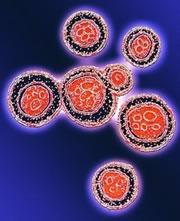 Cryptococcus neoformans could even be cultured on the outside of spacecraft.ALFRED PASIEKA / SCIENCE PHOTO LIBRARY
Cryptococcus neoformans could even be cultured on the outside of spacecraft.ALFRED PASIEKA / SCIENCE PHOTO LIBRARYFrom plastic to asbestos, cardboard to jet fuel, fungi will eat just about anything. Now researchers have found another dish in the fungal diet: radiation. Not radioactive compounds, which have long been known to be on the menu — radiation itself.
Ekaterina Dadachova and her colleagues at the Albert Einstein College of Medicine in New York have discovered that some fungi can use a molecule called melanin, a pigment also found in human skin, to harvest the energy from radiation and use it for growth.
This raises the prospect that astronauts could grow these fungi on long flights into radiation-rich outer space, suggests Dadachova's colleague Arturo Casadevall. The fungi aren't particularly appetizing, however — they resemble the mould on a dirty shower curtain.
Since the 1986 meltdown, at the Chernobyl Atomic Energy Station, the numbers of 'black fungi', rich in melanin, have risen steeply. Casadevall speculated that the fungi could be feeding on the radiation that contaminates the ruin of the nuclear reactor.
Dadachova, Casadevall and their colleagues tested how three different species of fungus respond to gamma radiation from rhenium-188 and tungsten-188. They found that all three, Cladosporium sphaerospermum, Cryptococcus neoformans and Wangiella dermatitidis, grow faster in the radiation's presence. The results are published in PLoS One.1
Heat seekers
Some fungi can decompose radioactive material such as the hot graphite in the remains of the Chernobyl reactor. Previous studies have shown that most fungi found in contaminated regions grow towards various different radiation sources, as if trying to reach these compounds2.
These fungi also tend to produce the pigment melanin, which is thought to protect fungi from a range of environmental stresses. "Under stress of exposure to ionizing radiation, microfungal communities in soil develop a higher proportion of melanin-containing fungal species," says John Dighton, a microbiologist at Rutgers University in New Brunswick, New Jersey.
ADVERTISEMENT
Dadachova's team found that exposure to radiation caused the fungal melanin molecule to change shape so that it was four times better at carrying out a common metabolic chemical reaction. Fungal strains without melanin generally did not grow faster in response to radiation.
Could the melanin in human skin cells likewise turn radiation into food? Casadevall speculates that it might, but the amount of energy provided would probably be very small — and certainly not enough for a busy astronaut. "Currently there is no evidence for this," says Casadevall, "however the fact that it occurs in fungi raises the possibility that the same may occur in animals and plants."
Visit our fungichomponradiatio.html">newsblog to read and post comments about this story.
